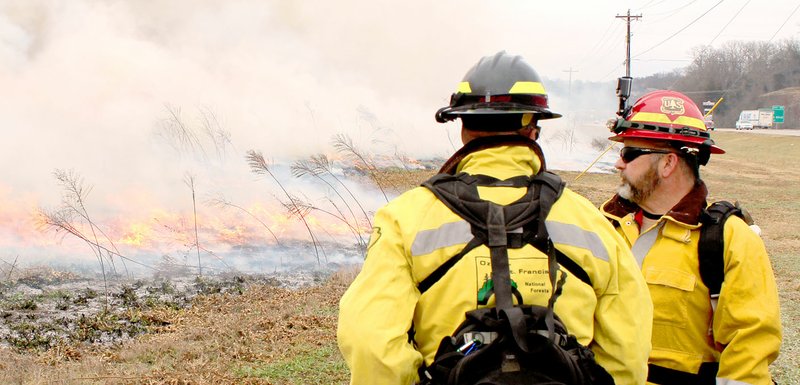Monday morning, the wildflower meadow sandwiched between U.S. Highway 71 and Lake Bella Vista was set ablaze.
The meadow, which had become overgrown with weeds near the end of the summer, was burned by the Arkansas Forestry Commission with help from the Bentonville and Bella Vista fire departments.
The goal of the fire, Forestry Commission county ranger George Stowe-Rains said, was to open up the seed-bed and kill some of the invasive plant life that had moved in.
Giving the fire departments a bit of wildfire practice, he said, was a nice bonus.
"It went relatively well," he said. "No smoke on the highway, which is fabulous."
Before a project like this can start, Stowe-Rains said, the weather has to be checked thoroughly. While the wind was sharper than they typical burn, he said, the humidity was also higher. With the extra humidity, he said, heavier winds were a boon.
Once the weather is good, he said, everyone involved sits down with a map and decides how to position themselves and what roles each unit is going to take. When everyone knows their position, he said, the burn can start.
"It's just like a well-oiled machine," he said. "They go to their spots and we all do a radio check and we get it lit and we patrol it."
The burn was started, he said, using a mixture of diesel and gasoline. The diesel burns longer, he said, which makes it better-suited to igniting brush, but it isn't volatile enough to easily light. Mixing gasoline in, he said, allows the fuel to readily ignite.
Stowe-Rains said earlier that the meadow would be burned against the wind. This, he said, will cause the fire to travel slower, which results in a more complete burn. The burn cleared roughly 80% of the vegetation in the area, he said.
A burn like this, he said, is thoroughly managed.
"We have a contingent plan," he said. "If it got out, we would quit igniting at that point and go ahead and attack what we call a slop-over or a jump-over, you know, any kind of an escape."
Alternatively, he said, a small escaping flame can be taken care of by one team while the remaining crews continue to burn.
Once the burn is complete, he said, the involved agencies do a mop-up, ensuring everything is actually burnt out and safe before they clear the scene. Someone, typically from the fire department, he said, will return later in the day to double check.
Tim Perkins, city horticulturalist for Bentonville, said that knocking down the vegetation should get rid of the invasive plant life that has worked its way into the meadow.
Lake Bella Vista is a Bentonville city park. Last spring the mowed field was slightly tilled and wildflower seeds were spread. It quickly bloomed into a profusion of color. But, as summer progressed, weeds took over.
"This is a five- to six-year process," Perkins said. "The goal is to increase the root mass of the native species that are here. The more you increase their root mass, the more they are able to choke out the invasive species. So we help them out along the way by burning and re-seeding."
While the patch of ground the meadow was on is mostly blackened at this point, he said, that should go away after the next rain or snow.
"We hope what happens out here in the spring, summer and fall offsets any eyesore," Perkins said. "We do have a plan to manage this over the next five to six years."
General News on 01/11/2017
